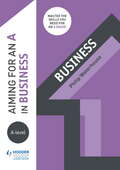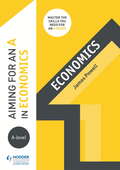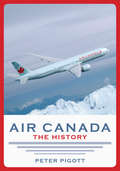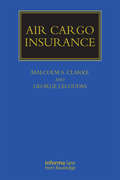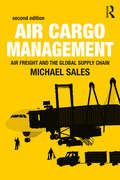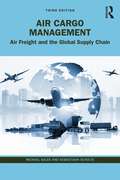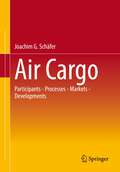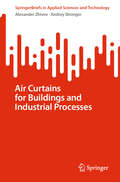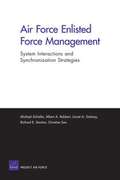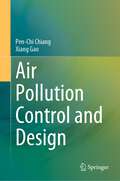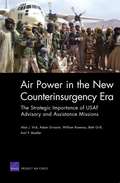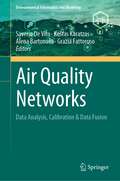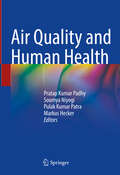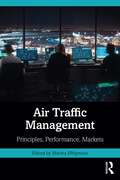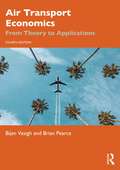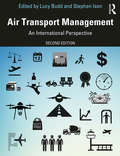- Table View
- List View
Aiming for an A in A-level Business
by Phil WaterhouseExam Board: AQA, Edexcel, OCR, WJEC/Eduqas Level: A-level Subject: Business First teaching: September 2015 First exams: Summer 2017Master the skills you need to set yourself apart and hit the highest grades; this year-round course companion develops the higher-order thinking skills that top-achieving students possess, providing step-by-step guidance, examples and tips for getting an A grade.Written by experienced author and teacher Phil Waterhouse, Aiming for an A in A-level Business:Helps you develop the 'A grade skills' of analysis, evaluation, creation and applicationTakes you step by step through specific skills you need to master in A-level Business, so you can apply these skills and approach each exam question as an A/A* candidateClearly shows how to move up the grades with sample responses annotated to highlight the key features of A/A* answersHelps you practise to achieve the levels expected of top-performing students, using in-class or homework activities and further reading tasks that stretch towards university-level studyPerfects exam technique through practical tips and examples of common pitfalls to avoid Cultivates effective revision habits for success, with tips and strategies for producing and using revision resources Supports all exam boards, outlining the Assessment Objectives for reaching the higher levels under the AQA, Edexcel, OCR and WJEC/Eduqas specifications.
Aiming for an A in A-level Economics
by James PowellExam Board: AQA, Edexcel, OCRLevel: A-levelSubject: EconomicsFirst teaching: September 2015First exams: Summer 2017Master the skills you need to set yourself apart and hit the highest grades; this year-round course companion develops the higher-order thinking skills that top-achieving students possess, providing step-by-step guidance, examples and tips for getting an A grade.Written by experienced author and teacher James Powell, Aiming for an A in A-level Economics:- Helps you develop the 'A grade skills' of analysis, evaluation, creation and application- Takes you step by step through specific skills you need to master in A-level Economics, so you can apply these skills and approach each exam question as an A/A* candidate- Clearly shows how to move up the grades with sample responses annotated to highlight the key features of A/A* answers- Helps you practise to achieve the levels expected of top-performing students, using in-class or homework activities and further reading tasks that stretch towards university-level study- Perfects exam technique through practical tips and examples of common pitfalls to avoid - Cultivates effective revision habits for success, with tips and strategies for producing and using revision resourcesSupports the major exam boards, outlining the Assessment Objectives for reaching the higher levels under the AQA, Edexcel and OCR specifications.
Aiming for an A in A-level Economics
by James PowellExam Board: AQA, Edexcel, OCRLevel: A-levelSubject: EconomicsFirst teaching: September 2015First exams: Summer 2017Master the skills you need to set yourself apart and hit the highest grades; this year-round course companion develops the higher-order thinking skills that top-achieving students possess, providing step-by-step guidance, examples and tips for getting an A grade.Written by experienced author and teacher James Powell, Aiming for an A in A-level Economics:- Helps you develop the 'A grade skills' of analysis, evaluation, creation and application- Takes you step by step through specific skills you need to master in A-level Economics, so you can apply these skills and approach each exam question as an A/A* candidate- Clearly shows how to move up the grades with sample responses annotated to highlight the key features of A/A* answers- Helps you practise to achieve the levels expected of top-performing students, using in-class or homework activities and further reading tasks that stretch towards university-level study- Perfects exam technique through practical tips and examples of common pitfalls to avoid - Cultivates effective revision habits for success, with tips and strategies for producing and using revision resourcesSupports the major exam boards, outlining the Assessment Objectives for reaching the higher levels under the AQA, Edexcel and OCR specifications.
Aiming for an Evolutionary Advantage: Management Innovation in Action
by Gary Hamel Bill BreenThis chapter takes an in-depth look at Google's one-of-a-kind management model, which is built around small work units, lots of experimentation, vigorous peer feedback, and a mission to improve the world. This chapter was originally published as chapter 6 of "The Future of Management."
Air Canada: The History
by Peter PigottBegun as a social experiment in 1937, Air Canada has evolved into one of the world’s greatest airlines. Air Canada: The History explores a modern miracle that has made commercial air travel in our country an everyday occurrence. The airline was born in 1937 as "Trans Canada Airlines," a ward of the Canadian National Railway. Renamed "Air Canada" in 1964 to reflect its status as a jet-age airline, it survived devastating air crashes, financial deficits, self-serving politicians, strikes, privatization, and the Airbus scandal. It was reviled in the nineties by the likes of Peter Newman, who joked, "If God had meant Man to fly, he wouldn’t have invented Air Canada." Today it is a much loved national icon. Fortunate at times to be run by great CEOs like Gordon McGregor and Claude Taylor, Air Canada has fought off a hostile takeover, merged with its arch-rival Canadian Airlines, and touched countless lives during its 75-year history. This is its story.
Air Cargo Insurance (Maritime and Transport Law Library)
by Malcolm A. Clarke George LeloudasApproximately 40 per cent of value of international trade comes from goods carried by air, and the consequences of goods being damaged, destroyed or delayed can be serious, substantial, and perhaps unforeseen. This exciting new book is the only one on the market that deals exclusively with air cargo insurance, and will therefore, be a vital addition to the collection of any practitioner, professional or academic working in the field. Air Cargo Insurance analyses the model policies and standard terms and conditions on the London markets. The authors also provide readers with an invaluable perspective on cases in other jurisdictions, and the book discusses freight forwarders’ relations with airlines and addresses the possibility of recovery from third parties. This book, written by two of the leading experts in the field, provides invaluable guidance to practitioners, arbitrators and cargo-claims professionals. It will help to ensure that air cargo insurance contracts are better drafted and enforceable, as well as assisting in cases of disputed claims. Academics and postgraduate students specialising in the areas of in air and insurance law will also find this book extremely useful.
Air Cargo Management: Air Freight and the Global Supply Chain
by Michael SalesAir Cargo Management provides a comprehensive and lively overview of the air cargo industry, which is both economically and strategically important in the field of logistics, world trade and supply chain management. This new edition builds on the success of the previous edition, focusing on the role of air freight in the global supply chain, including areas such as: the main players in the industry; regulations and restrictions; and terrorism management. Updates to this edition include: the role of E-Commerce and its changing influence on the industry; a new chapter on crime, security and terrorism; updated case studies, and new contributors providing professional insight from the industry. Enriched throughout with international case studies and contributions from industry experts, Air Cargo Management provides a practical approach. It is the perfect companion for undergraduate students studying air logistics, transportation logistics, air cargo and supply chain management. Professionals and managers in the field will also find Sales’ easy style and industry insights useful and applicable to their practice.
Air Cargo Management: Air Freight and the Global Supply Chain
by Michael Sales Sebastiaan ScholteThis is the third edition of a popular introductory guide to the function and future of the air cargo supply chain, an industry which responded with remarkable efficiency when faced with the challenges and impact of the COVID-19 pandemic. The book reviews the role and strategy of air cargo and its contribution to world trade and international economies. This industry, which accounts for more than 35% of the world’s trade in value, will be even more vital in the coming years. Building on the success of previous editions, Air Cargo Management now puts the emphasis on basic functionality, economics and historical precedents, but most of all it focuses on how traditional legacy methods are being replaced by the adoption of technologies and cloud-based applications – new methods which are changing and streamlining the entire industry. The book reviews the supply chain process and the technology applications as well as the effects of the pandemic and the fundamental lack of cargo capacity hitherto supplied by passenger aircraft. It also explores the increased use of freighter aircraft and the need for faster and more efficient processing, particularly on the ground and in road transport. The third edition features new content on: Security and crime, including pharmaceutical counterfeiting and fraud The role of airports and road feeder services Typical air cargo products, including the heavy-lift sector Regulations and treaties Aircraft in use, historically and currently New technologies The book is illustrated with statistical evidence, examples and photographs and is enriched with comments from industry leaders and experienced professionals. The style and breadth of content are designed to be easily readable and should be of practical interest to anyone either currently working in the logistics, supply chain or transport industries, or contemplating a career in this sector.
Air Cargo: Participants - Processes - Markets - Developments
by Joachim G. SchäferThis book uses numerous examples to describe the current opportunities and risks of air freight against the backdrop of stagnating transport volumes since the financial crisis in 2008. It shows what impact these developments have had on those involved, in particular shippers, airlines, airports and freight forwarders. The application-oriented presentation also provides an insight into the design of complex supply chains and the areas of tension in which the players in air freight operate.
Air Castle of the South: WSM and the Making of Music City
by Craig HavighurstStarted by the National Life and Accident Insurance Company in 1925, WSM became one of the most influential and exceptional radio stations in the history of broadcasting and country music. WSM gave Nashville the moniker "Music City USA" as well as a rich tradition of music, news, and broad-based entertainment. With the rise of country music broadcasting and recording between the 1920s and '50s, WSM, Nashville, and country music became inseparable, stemming from WSM's launch of the Grand Ole Opry, popular daily shows like Noontime Neighbors, and early morning artist-driven shows such as Hank Williams on Mother's Best Flour. Sparked by public outcry following a proposal to pull country music and the Opry from WSM-AM in 2002, Craig Havighurst scoured new and existing sources to document the station's profound effect on the character and self-image of Nashville. Introducing the reader to colorful artists and businessmen from the station's history, including Owen Bradley, Minnie Pearl, Jim Denny, Edwin Craig, and Dinah Shore, the volume invites the reader to reflect on the status of Nashville, radio, and country music in American culture.
Air Curtains for Buildings and Industrial Processes (SpringerBriefs in Applied Sciences and Technology)
by Alexander Zhivov Andrey StronginThis book is based on several decades of authors’ research and practical experience in the areas of industrial and commercial buildings ventilation and energy efficiency as well as in process optimization in different types of industrial facilities. The Book discusses different types of air curtains used around the world and describes design, applications, pros and cons and examples for each type of air curtain. The book is illustrated with schematics of air curtains and pictures from their real-life implementation from around-the -world. To compare various design of air curtains, authors propose several indicators/efficiency criteria, which address effectiveness of air curtains, their energy and performance efficiency. The target audience for this book are energy and process engineers and designers of large commercial and industrial facilities, warehouses, and hangars.
Air Force Enlisted Force Management
by Albert A. Robbert Richard E. Stanton Christine San Lionel A. Galway Michael SchieferA fundamental goal of the Air Force personnel system is to ensure that the manpower inventory, by Air Force specialty code and grade, matches requirements. However, there are structural obstacles that impede achieving this goal. To remove one of those obstacles, the authors propose a methodology that would marginally modify grade authorizations within skill levels to make it possible to better achieve manpower targets.
Air Pollution Brings Down the Stock Market
by Scott Berinato Anthony HeyesHBR Interview - When researchers compared daily data from the S&P 500 index with daily environmental data from Lower Manhattan, they discovered a connection between poor air quality and diminished stock performance.
Air Pollution Control and Design
by Pen-Chi Chiang Xiang GaoThis book focuses specifically on the environmental issues related to the air pollution control and design. It is divided into four parts: (1) Fundamentals of air pollution control, (2) fundamentals of energy utilization, (3) gaseous control and design, and (4) particulate control and design, each consisting of four to six chapters. The topics covered in this book not only introduce the basic concepts of air pollution control and design but also address the fundamentals of energy utilization in the context of good engineering practice and policy instruments. It also features several innovative technologies and integrated methodologies relating to gaseous and particulate matter control and design. To facilitate technology integration and meet the need for comprehensive information on sustainable development, the book discusses a wide range of areas concerning the principles, applications, and assessment of air pollution control and design and thermodynamics, heat transfer, advanced combustion and renewable energy for energy utilization. It also features regulations and policy instruments adopted around the globe as well as several case studies. Presenting the emerging challenges, new concepts, innovative methodologies, and resolving strategies, as well as illustrative and inspiring case studies, it appeals to a wide range of readers, such as researchers, graduate students, engineers, policy makers, and entrepreneurs.
Air Power in the New Counterinsurgency Era: The Strategic Importance of USAF Advisory and Assistance Missions
by Beth Grill William Rosenau Alan J. Vick Karl P. Mueller Adam GrissomUnited States has engaged in counterinsurgency around the globe for more than a century. But insurgencies have rarely been defeated by outside powers. Rather, the afflicted nation itself must win the war politically and militarily, and the best way to help is to offer advice, training, and equipment. Air power, and the U.S. Air Force, can play an important role in such efforts, which suggests making them an institutional priority.
Air Products' Pursuit of Airgas (A)
by Paul M. Healy Penelope Rossano Charles C.Y. Wang Kyle ThomasThis case centers around the Air Products' hostile takeover attempt of Airgas in 2010. Air Products argued that its offer of a 38% premium is generous given Airgas' poor performance, which Air Products attributed to underperforming and entrenched managers at Airgas. On the other hand, Airgas' management argued that the company's recent struggles are cyclical and that Air Products' offer grossly undervalues Airgas' long-run potential. How might Airgas' management credibly communicate its conviction to shareholders? Should Airgas shareholders side with Air Products and accept a certain short term return, or should they side with Airgas' management and accept an uncertain but potentially higher long-term outcome? How should the Airgas board balance its responsibilities to short-term versus long-term shareholders?
Air Products’ Pursuit of Airgas (C)
by Paul M. Healy Charles C.Y. Wang Kyle ThomasSupplement - This case centers around the Air Products' hostile takeover attempt of Airgas in 2010. Air Products argued that its offer of a 38% premium is generous given Airgas' poor performance, which Air Products attributed to underperforming and entrenched managers at Airgas. On the other hand, Airgas' management argued that the company's recent struggles are cyclical and that Air Products' offer grossly undervalues Airgas' long-run potential. How might Airgas' management credibly communicate its conviction to shareholders? Should Airgas shareholders side with Air Products and accept a certain short term return, or should they side with Airgas' management and accept an uncertain but potentially higher long-term outcome? How should the Airgas board balance its responsibilities to short-term versus long-term shareholders?
Air Products’ Pursuit of Airgas (D)
by Paul M. Healy Charles C.Y. Wang Kyle ThomasSupplement - This case centers around the Air Products' hostile takeover attempt of Airgas in 2010. Air Products argued that its offer of a 38% premium is generous given Airgas' poor performance, which Air Products attributed to underperforming and entrenched managers at Airgas. On the other hand, Airgas' management argued that the company's recent struggles are cyclical and that Air Products' offer grossly undervalues Airgas' long-run potential. How might Airgas' management credibly communicate its conviction to shareholders? Should Airgas shareholders side with Air Products and accept a certain short term return, or should they side with Airgas' management and accept an uncertain but potentially higher long-term outcome? How should the Airgas board balance its responsibilities to short-term versus long-term shareholders?
Air Quality Networks: Data Analysis, Calibration & Data Fusion (Environmental Informatics and Modeling)
by Kostas Karatzas Saverio De Vito Alena Bartonova Grazia FattorusoThis volume offers expert contributions proposing new and recently set scientific standards for smart air quality (AQ) networks data processing, along with results obtained during field deployments of pervasive and mobile systems. The book is divided into 5 main sections; 1) future air quality networks, 2) general data processing techniques, 3) field deployments performances, 4) special applications, and 5) cooperative and regulatory efforts. The authors offer different sources of data for the production of trustworthy insights, including spatio-temporal predictive AQ maps meant to boost citizen awareness, and informed participation in remediation and prevention policies. Readers will learn about the best and most up-to-date practices for measuring and assessing air quality, while also learning about current regulatory statuses regarding air quality technology design and implementation. The book will be of interest to air quality regulatory agencies, citizen science groups, city authorities, and researchers and students working with air quality sensors and geostatistics.
Air Quality and Human Health
by Markus Hecker Pratap Kumar Padhy Soumya Niyogi Pulak Kumar PatraThe book is one of the outcomes of the SPARC (Scheme for Promotion of Academic and Research Collaboration) project titled "Fine particulates matters in the air environment and their cancer risks in human beings," sponsored by MHRD (now MoE), Govt. of India. The editors of the book are PIs and Co-PIs of the said project. The text deliberates on air pollution's health risks with contributions from well-known experts from diverse research fields (environmental science, toxicology, geology, public health science, biology, physics, chemistry, and geospatial technology). It explores it its control and mitigation strategies. The book provides an up-to-date overview of the modern methods and tools used in air quality monitoring and human health risk assessment. Case studies from different global settings offer invaluable insights into air pollution-related regional health issues. It addresses all aspects of air quality, covering indoor-outdoor air pollution, gaseous and particulate pollutants; characterization of source and pathways of air pollutants; and the modeling and assessing of health risks (respiratory, epidemiological, and toxicological) with regional and global perspectives. It also addresses air quality management issues. The lucid explanation of the role of oxidative stress mechanisms and molecular biomarkers (genomics, proteomics) may be considered as inputs into the development of cancer therapeutics. Along with providing a scientific basis for air pollution, this book will help readers appreciate the environmental determinants of public health and apply research evidence to improve the quality of life. It also delineates future research initiatives and policy actions needed to protect human health from air pollution, locally and globally. The book will be of great educational value and help for consultation and teaching.
Air Traffic Controllers
by Michael Beer Bert A. SpectorOn August 3, 1981 President Ronald Reagan terminated 12,000 air traffic controllers, members of the Professional Air Traffic Controllers Organization, for violating their no-strike oath. Provides background on the human resources policies and practices of the Federal Aviation System and information concerning the negotiations and impact of the terminations.
Air Traffic Management: Principles, Performance, Markets
by Marina EfthymiouThis book addresses each of the Air Navigation Services' five broad categories of services provided to air traffic during all phases of operation: air traffic management (ATM), communication, navigation and surveillance services (CNS), meteorological services for air navigation (MET), aeronautical information services (AIS) and search and rescue (SAR). This book is designed for working professionals in Air Transport Management, but also undergraduate and postgraduate students studying air transport management and aeronautical engineering. It will also be very helpful for the training of air traffic control officers (ATCOs). The book does not require any prior (specialist) knowledge as it is an introduction to air navigation service provider (ANSP) business. There is very little literature available that gives a detailed appreciation of the complexities, potential risks and issues associated with the provision of air navigation services. The role of this book is to fill this significant gap with a comprehensive, in-depth study of the management principles related to ANSPs. This is particularly timely given recent ATC developments in Europe, USA and New Zealand. Airlines and airports rely on the ANSPs for the management of air traffic. Hence, air navigation services (ANS) provision is considered as a core element for air transportation.
Air Transport Economics: From Theory to Applications
by Brian Pearce Bijan VasighAir Transport Economics: From Theory to Applications uniquely merges the institutional and technical aspects of the aviation industry with their theoretical economic underpinnings. Its integrative approach offers a fresh point of view that will find favor with many students of aviation. This fourth edition has undergone extensive updates throughout. It features new material addressing the impact of COVID-19 on the air transport industry, and the efforts made by both the industry and governments to facilitate recovery. A new chapter examines the impact of air transport on climate change and how government policies to address this issue could reshape the industry. Additionally, alongside expanded coverage of revenue management and pricing decisions, this fourth edition incorporates case studies that give real-world examples to reflect current industry practices. Moreover, there is a discussion of the latest computer applications that enhance the effectiveness of the new techniques. This book offers a self-contained theory and applications-oriented text for individuals aspiring to enter the aviation industry as a practicing professional in the management area. It will be of the greatest relevance to undergraduate and graduate students aiming to acquire a comprehensive grasp of the economics of the aviation industry. The review questions at the end of each chapter have been expanded considerably, and an online assignment has been introduced for each chapter. This book will also appeal to many professionals who seek an accessible and practical explanation of the underlying economic forces that shape the industry.
Air Transport Management: An International Perspective
by Lucy BuddAir Transport Management: An International Perspective provides in-depth instruction in the diverse and dynamic area of commercial air transport management. The 2nd edition has been extensively revised and updated to reflect the latest developments in the sector. The textbook includes both introductory reference material and more advanced content so as to provide a solid foundation in the core principles and practices of air transport management. This 2nd edition includes a new chapter on airline regulation and deregulation and new dedicated chapters focusing on aviation safety and aviation security. Four new contributors bring additional insights and expertise to the book. The 2nd edition retains many of the key features of the 1st edition, including: • A clearly structured topic-based approach that provides information on key air transport management issues including: aviation law, economics; airport and airline management; finance; environmental impacts, human resource management; and marketing; • Chapters authored by leading air transport academics and practitioners worldwide which provide an international perspective; • Learning objectives and key points which provide a framework for learning; • Boxed case studies and examples in each chapter; • Keyword definitions and stop and think boxes to prompt reflection and aid understanding of key terms and concepts. Designed for undergraduate and postgraduate students studying aviation and business management degree programmes and industry practitioners seeking to expand their knowledge base, the book provides a single point of reference to the key legal, regulatory, strategic and operational concepts and processes that shape the form and function of the world’s commercial air transport industry.
